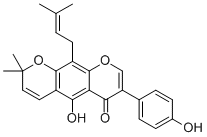Home
Products
Warangalone



| Product Name | Warangalone |
| Price: | Inquiry |
| Catalog No.: | CN04964 |
| CAS No.: | 4449-55-2 |
| Molecular Formula: | C25H24O5 |
| Molecular Weight: | 404.5 g/mol |
| Purity: | >=98% |
| Type of Compound: | Flavonoids |
| Physical Desc.: | Yellow powder |
| Source: | The herbs of Erythrina addisoniae |
| Solvent: | Chloroform, Dichloromethane, Ethyl Acetate, DMSO, Acetone, etc. |
| SMILES: |
| Contact us | |
|---|---|
| First Name: | |
| Last Name: | |
| E-mail: | |
| Question: | |
| Description | Warangalone is an anti-malarial compound which can inhibit the growth of both strains of parasite 3D7 (chloroquine sensitive) and K1 (chloroquine resistant) with IC50s of 4.8 μg/mL and 3.7 μg/mL, respectively. Warangalone can also inhibit cyclic AMP-dependent protein kinase catalytic subunit (cAK) with an IC50 of 3.5 μM. |
| Target | IC50: 4.8 μg/mL (3D7), 3.7 μg/mL (K1)[1] IC50: 3.5 μM (cAK)[2] |
| In Vitro | Warangalone is an anti-malarial compound which can inhibit the growth of both strains of parasite 3D7 (chloroquine sensitive) and K1 (chloroquine resistant) with IC50s of 4.8 μg/mL and 3.7 μg/mL, respectively[1]. Warangalone can also inhibit cyclic AMP-dependent protein kinase catalytic subunit (cAK) with an IC50 of 3.5 μM[2]. When HL-60 cells are exposed to Warangalone (30 μM) for 24 h, Warangalone induces a significant decrease (8%) in cell viability compare to controls. Warangalone also inhibits HL-60 cell growth within 24 h in a time-dependent fashion. A time-dependent increase in caspase-9 activity is observed in Warangalone-treated cells[3]. |
| Cell Assay | Cell viability is determined using the Cell Titer 96 Aqueous assay kit. Cells are seeded in 96-well plates at a density of 1×105 cells per well. The cells are maintained for 24 h at 37°C and then Warangalone (30 μM) is added to the culture medium. MTS solution is added to the 96-well plates at the indicated time points, and the cells are incubated for 1 h at 37°C. The absorbance is measured at a wavelength of 490 nm with a microplate counter[3]. |
| Density | 1.3±0.1 g/cm3 |
| Boiling Point | 627.0±55.0 °C at 760 mmHg |
| Flash Point | 216.7±25.0 °C |
| Exact Mass | 404.162384 |
| PSA | 79.90000 |
| LogP | 7.87 |
| Vapour Pressure | 0.0±1.9 mmHg at 25°C |